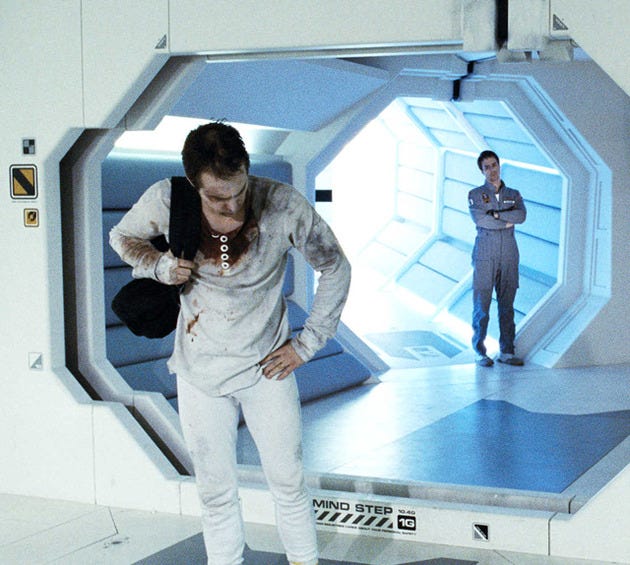
Duncan Jones’ Moon (2009) opens with an advertisement for Lunar Industries, the clean energy company at the heart of the film’s themes. It begins with dystopian scenes of polluted landscapes, overflowing landfills, and impoverished people, but quickly transitions to the promise of a future of plentiful clean energy achieved by harvesting the solar energy stores in moon rocks in the form of helium-3: “the power of our future.”
Sceptics might be quick to point out that while solar power may prove a plentiful and clean source of renewable energy, the idea that solar energy is somehow “stored” in Moon rocks waiting to be mined like a mineral deposit strains credulity. Rather than bemoan the weak scientific premises of so much science fiction film, however, let’s focus instead on the medium and ask what Jones achieves in the visual design of Moon.
Most of the film takes place in a moon base whose starkly white non-spaces, to use Mark Augé’s language, create a sleekly futuristic yet cold and anonymous environment in which our lonely solitary miner, Sam (Sam Rockwell), labors on a three-year contract. The interior of the station evokes the design of Stanley Kubrick’s orbital moon base in 2001: A Space Odyssey (1968), a celebrated film about the future of humanity. Unlike the measured professional tones of Kubrick’s astronauts, however, Sam has the demeanor of a working-class, oil-rig roughneck, and the exterior scenes of his work foreground large machinery that dominates over the human: the same harsh conditions of manual labor that have given us our energy stores from whale oil to coal to petroleum. Moon is about the collision of polished images of the future with the ugly costs — to the environment, to personnel — of securing this energy.
Moon’s narrative focus is on Sam and his overwhelming isolation as the sole human crewperson manning this mostly automated system. The inhumanity of this economy of extraction (of energy, of surplus value) is made starkly visible when Sam eventually learns he is just another dispensable part of this system, a clone who will be incinerated when his labor-power (and life) are used up. He will be replaced by a store of identical Sams all waiting to serve their three-years, sustained by the illusion that they are the original, human Sam.
Like Kubrick, Jones is interested in thinking about the future of the human. Yet the future he sees is not the evolutionary leap into the starchild, but the inherent dehumanizations of global capital. On one level, Sam is a biological machine, but given that he — and we — do not know this for most of the film, he also comes alive as a character, as an individual human being with dreams and loves and loneliness and hopes for a future that can never be his. As much as Sam sits comfortably in a line of exploited created beings from Asimov’s robots to Blade Runner’s replicants, he fits as well in the company of all those whose deprivation and harsh labor make possible — for a few of us — the lives of plentiful and cheap energy consumption promised by Lunar Industry’s utopian vision. Moon reminds us to keep in mind the human costs of our shiny high-tech fixes. The future is about rethinking social organization as much as it is about rethinking technology.
This piece is part of Science Fiction Frames: a series of incisive analyses, thoughtful meditations, wild theories, close readings, and speculative leaps jumping off from a single frame of a science fiction film or television show. If you would like to contribute to the series or learn more, email us at imagination@asu.edu.
